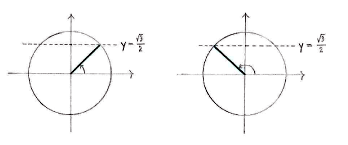Solution 4.4:2a
From Förberedande kurs i matematik 1
m (Lösning 4.4:2a moved to Solution 4.4:2a: Robot: moved page) |
|||
| Line 1: | Line 1: | ||
| - | + | We draw a unit circle and mark on those angles on the circle which have a | |
| - | < | + | <math>y</math> |
| - | {{ | + | -coordinate of |
| - | { | + | <math>{\sqrt{3}}/{2}\;</math>, in order to see which solutions lie between |
| - | < | + | <math>0</math> |
| - | + | and | |
| + | <math>2\pi </math>. | ||
| + | |||
[[Image:4_4_2_a.gif|center]] | [[Image:4_4_2_a.gif|center]] | ||
| + | |||
| + | In the first quadrant, we recognize | ||
| + | <math>x={\pi }/{3}\;</math> | ||
| + | as the angle which has a sine value of | ||
| + | <math>{\sqrt{3}}/{2}\;</math> | ||
| + | and then we have the reflectionally symmetric solution | ||
| + | <math>x=\pi -\frac{\pi }{3}=\frac{2\pi }{3}</math> | ||
| + | in the second quadrant. | ||
| + | |||
| + | Each of those solutions returns to itself after every revolution, so that we obtain the complete solution if we add multiples of | ||
| + | <math>2\pi </math> | ||
| + | |||
| + | |||
| + | |||
| + | <math>x=\frac{\pi }{3}+2n\pi </math> | ||
| + | and | ||
| + | <math>x=\frac{2\pi }{3}+2n\pi </math> | ||
| + | |||
| + | |||
| + | where | ||
| + | <math>n</math> | ||
| + | is an arbitrary integer. | ||
| + | |||
| + | NOTE: when we write that the complete solution is given by | ||
| + | |||
| + | |||
| + | <math>x=\frac{\pi }{3}+2n\pi </math> | ||
| + | and | ||
| + | <math>x=\frac{2\pi }{3}+2n\pi </math>, | ||
| + | |||
| + | this means that for every integer | ||
| + | <math>n</math>, we obtain a solution to the equation: | ||
| + | |||
| + | |||
| + | <math>\begin{array}{*{35}l} | ||
| + | n=0 & x=\frac{\pi }{3} & x=\frac{2\pi }{3} \\ | ||
| + | n=-1 & x=\frac{\pi }{3}+\left( -1 \right)\centerdot 2\pi & x=\frac{2\pi }{3}+\left( -1 \right)\centerdot 2\pi \\ | ||
| + | n=1 & x=\frac{\pi }{3}+1\centerdot 2\pi & x=\frac{2\pi }{3}+1\centerdot 2\pi \\ | ||
| + | n=-2 & x=\frac{\pi }{3}+\left( -2 \right)\centerdot 2\pi & x=\frac{2\pi }{3}+\left( -2 \right)\centerdot 2\pi \\ | ||
| + | n=2 & x=\frac{\pi }{3}+2\centerdot 2\pi & x=\frac{2\pi }{3}+2\centerdot 2\pi \\ | ||
| + | \end{array}</math> | ||
| + | |||
| + | and so on. | ||
Revision as of 13:30, 30 September 2008
We draw a unit circle and mark on those angles on the circle which have a \displaystyle y -coordinate of \displaystyle {\sqrt{3}}/{2}\;, in order to see which solutions lie between \displaystyle 0 and \displaystyle 2\pi .
In the first quadrant, we recognize \displaystyle x={\pi }/{3}\; as the angle which has a sine value of \displaystyle {\sqrt{3}}/{2}\; and then we have the reflectionally symmetric solution \displaystyle x=\pi -\frac{\pi }{3}=\frac{2\pi }{3} in the second quadrant.
Each of those solutions returns to itself after every revolution, so that we obtain the complete solution if we add multiples of \displaystyle 2\pi
\displaystyle x=\frac{\pi }{3}+2n\pi and \displaystyle x=\frac{2\pi }{3}+2n\pi
where
\displaystyle n
is an arbitrary integer.
NOTE: when we write that the complete solution is given by
\displaystyle x=\frac{\pi }{3}+2n\pi
and
\displaystyle x=\frac{2\pi }{3}+2n\pi ,
this means that for every integer \displaystyle n, we obtain a solution to the equation:
\displaystyle \begin{array}{*{35}l}
n=0 & x=\frac{\pi }{3} & x=\frac{2\pi }{3} \\
n=-1 & x=\frac{\pi }{3}+\left( -1 \right)\centerdot 2\pi & x=\frac{2\pi }{3}+\left( -1 \right)\centerdot 2\pi \\
n=1 & x=\frac{\pi }{3}+1\centerdot 2\pi & x=\frac{2\pi }{3}+1\centerdot 2\pi \\
n=-2 & x=\frac{\pi }{3}+\left( -2 \right)\centerdot 2\pi & x=\frac{2\pi }{3}+\left( -2 \right)\centerdot 2\pi \\
n=2 & x=\frac{\pi }{3}+2\centerdot 2\pi & x=\frac{2\pi }{3}+2\centerdot 2\pi \\
\end{array}
and so on.

